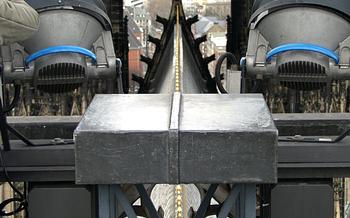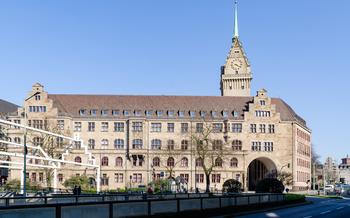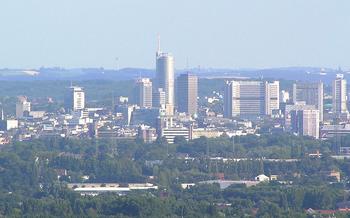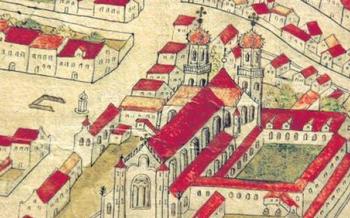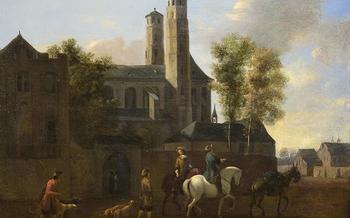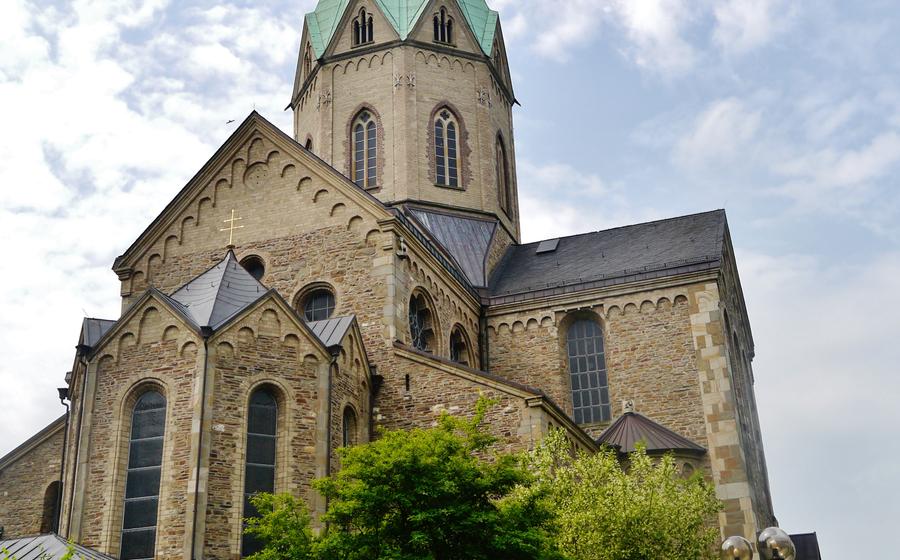
Basilica of St. Ludgerus
- The Basilica of St. Ludgerus: A Historical and Architectural Gem
- Exploring the Interior of the Basilica
- Marveling at the Art and Architecture
- Unveiling the History of St. Ludgerus
- Attending Mass and Religious Services
- Discovering the Treasures of the Cathedral
- Stepping Back in Time at the Domschatzkammer
- Pilgrimage and Spirituality at the Basilica
- Exploring the Surrounding Area
- Events and Festivals at the Basilica
- The Basilica as a Cultural Center
- Capture the Essence of the Basilica
- Insider Tip: Off-the-Beaten-Track Experiences
The Basilica of St. Ludgerus: A Historical and Architectural Gem
The Basilica of St. Ludgerus in Essen, Germany, stands as a testament to the enduring legacy of its namesake saint and the profound influence of Christianity on the region. With roots dating back to the 9th century, the basilica has undergone several transformations over the centuries, reflecting the changing architectural styles and the growing prominence of the city.
In the early 9th century, St. Ludgerus, a Benedictine monk and missionary, established a church and a monastic community on the site where the basilica now stands. This humble beginning marked the foundation of the city of Essen, which would later become a thriving religious and cultural center.
The original church was replaced by a larger Romanesque structure in the 11th century, featuring a distinctive basilica plan with a nave flanked by two aisles. The basilica's most striking feature, the towering Gothic choir, was added in the 13th century, lending a sense of grandeur and elegance to the building.
The Basilica of St. Ludgerus is not only a masterpiece of architecture but also holds immense religious significance. It is dedicated to St. Ludgerus, the patron saint of Essen, who played a pivotal role in spreading Christianity throughout the region. The basilica serves as a place of worship, pilgrimage, and spiritual renewal for countless believers from Essen and beyond.
Exploring the Interior of the Basilica
Step inside the Basilica of St. Ludgerus, and prepare to be awestruck by its magnificent interior. The vast nave, flanked by elegant side aisles, leads the eye towards the chancel and apse, creating a sense of awe and grandeur. The intricate Gothic-inspired columns soar upwards, supporting intricate rib vaults that seem to dissolve into the ethereal heights above.
Adorned with exquisite stained glass windows, the basilica radiates with a kaleidoscope of vibrant hues, illuminating the sacred space with divine light. Each window tells a biblical story or depicts a saintly figure, casting a mystical glow upon the interior.
Throughout the basilica, you'll find an array of notable altars and statues that showcase the artistry and devotion of past generations. The high altar, a masterpiece of craftsmanship, is adorned with intricate carvings and gleaming gold leaf, drawing the eye to the majestic crucifix that stands at its center.
Don't miss the opportunity to explore the crypt and treasury, hidden beneath the main floor of the basilica. In the crypt, you'll find the final resting place of St. Ludgerus, whose remains are interred in a magnificent shrine. The treasury, meanwhile, houses a collection of precious artifacts, including reliquaries, gold and silverwork, and ancient manuscripts, offering a glimpse into the basilica's rich history.
Marveling at the Art and Architecture
The Basilica of St. Ludgerus stands as a testament to the exquisite artistry and architectural prowess of its creators. Its Gothic-inspired design is evident in the pointed arches, ribbed vaults, and intricate tracery windows. The interior of the basilica is adorned with vibrant stained glass windows, which depict biblical scenes and the lives of saints. These magnificent windows allow multicolored light to filter into the basilica, creating an ethereal and awe-inspiring ambiance.
Intricate carvings and sculptures grace the walls, columns, and altars of the basilica. These carvings depict scenes from the Bible, saints, and mythical creatures. The attention to detail is remarkable, and each carving tells a unique story. The grand organ, with its ornate pipes and intricate carvings, is a masterpiece of craftsmanship. Its majestic sound fills the basilica during services and concerts, adding to the spiritual and uplifting atmosphere.
Unveiling the History of St. Ludgerus
St. Ludgerus, a revered figure in the annals of German history, played a pivotal role in the spread of Christianity throughout the region. Born in the Netherlands around 742 AD, he dedicated his life to missionary work and the establishment of religious communities. In 777 AD, Ludgerus arrived in the town of Essen, where he founded a church and a Benedictine monastery.
The church, later known as the Basilica of St. Ludgerus, became a focal point for religious devotion and scholarship. Ludgerus himself served as its first abbot, guiding his community with wisdom and compassion. Under his leadership, the monastery flourished as a center of learning and spirituality.
Ludgerus's tireless efforts in spreading the Christian faith earned him widespread recognition and respect. In 804 AD, he was appointed as the first bishop of Münster, where he continued his missionary work and strengthened the foundations of the diocese. Throughout his life, Ludgerus remained committed to fostering unity and understanding among different religious communities.
Following his death in 809 AD, Ludgerus was canonized as a saint, and his legacy continued to inspire generations to come. The Basilica of St. Ludgerus stands as a testament to his enduring impact, serving as a place of pilgrimage, prayer, and spiritual renewal for countless believers.
Attending Mass and Religious Services
For those seeking a deeper spiritual connection, attending a mass or religious service at the Basilica of St. Ludgerus is a profound and moving experience. The basilica's hallowed halls echo with centuries of devotion and faith, creating an atmosphere of reverence and awe.
Schedule of Masses and Services
Masses and religious services are held regularly throughout the week, catering to the needs of the diverse congregation. Visitors can check the basilica's official website or inquire at the information desk for the exact schedule.
Participating in Worship
Participating in a mass or service at the basilica offers a unique opportunity to immerse oneself in the community of believers and experience the sacred traditions of the Catholic Church. Visitors are welcome to join in the prayers, hymns, and rituals, following the lead of the officiating priest or deacon.
Proper Dress Code and Etiquette
While there is no strict dress code for attending mass or services at the basilica, visitors are encouraged to dress respectfully and modestly. This demonstrates reverence for the sacred space and consideration for fellow worshippers.
Experiencing the Sacred Atmosphere
The basilica's grand interior, adorned with intricate artwork, stained glass windows, and flickering candles, creates a deeply spiritual atmosphere. The harmonious blend of music, prayers, and the collective devotion of the congregation evokes a sense of peace, tranquility, and awe.
Discovering the Treasures of the Cathedral
The Basilica of St. Ludgerus is home to a trove of religious artifacts and treasures that captivate visitors with their historical significance and artistic beauty. Among the most notable is the Ludgerus Shrine, an elaborate reliquary that holds the remains of St. Ludgerus, the basilica's patron saint. The shrine is adorned with intricate carvings, precious metals, and gemstones, showcasing the exquisite craftsmanship of medieval artisans.
Other notable treasures include a collection of reliquaries and artifacts associated with St. Ludgerus and other saints. These include reliquaries containing fragments of bones, clothing, or other personal items, as well as liturgical objects such as chalices, crosiers, and monstrances. The basilica also houses a collection of precious metalwork, including gold and silver vessels, reliquaries, and decorative objects. These items testify to the wealth and patronage that the basilica enjoyed throughout its history.
Finally, the basilica's Cathedral Treasury Museum offers a deeper dive into the history and significance of these treasures. The museum displays a rotating selection of artifacts from the basilica's collection, providing visitors with an up-close look at the exquisite craftsmanship and rich symbolism of these sacred objects.
Stepping Back in Time at the Domschatzkammer
Step into the Domschatzkammer, or Cathedral Treasury, and embark on a journey through time as you discover rare artifacts and ecclesiastical treasures that narrate the rich history of the Basilica of St. Ludgerus. This captivating museum houses an impressive collection of medieval art and craftsmanship, offering a glimpse into the artistic and cultural heritage of the region.
Marvel at the intricate goldsmith work, delicate tapestries, and exquisitely crafted reliquaries that adorn the displays. Immerse yourself in the stories behind these priceless objects, each one a testament to the faith, devotion, and artistry of past generations.
Don't miss the highlight of the collection – the Ludgerus Shrine, a magnificent masterpiece of gold and silver that holds the relics of St. Ludgerus. This exquisite shrine, adorned with intricate carvings and precious gemstones, is a symbol of the enduring legacy of the saint and the profound veneration he continues to receive.
Interactive exhibits and displays bring the history of the Cathedral Treasury to life, allowing visitors to delve deeper into the significance of these artifacts and their role in shaping the cultural and spiritual identity of the region. Through engaging storytelling and multimedia presentations, the Domschatzkammer provides a captivating and immersive experience for visitors of all ages.
Whether you're a history buff, an art enthusiast, or simply curious about the spiritual heritage of Germany, the Domschatzkammer is an absolute must-visit. Prepare to be transported back in time as you explore this treasury of sacred and historical wonders.
Pilgrimage and Spirituality at the Basilica
The Basilica of St. Ludgerus holds a profound significance as a pilgrimage site, drawing countless believers and seekers of spiritual renewal to its sacred grounds. The veneration of St. Ludgerus, a revered missionary and patron saint of the region, has made the basilica a popular destination for pilgrims throughout history. Pilgrims undertake arduous journeys to pay homage to the saint, seeking his intercession and guidance.
Along the pilgrimage routes, wayside shrines and chapels dedicated to St. Ludgerus mark the paths, providing resting places for weary travelers and opportunities for prayer and reflection. Pilgrims often carry relics or symbols associated with the saint, believing in their protective and healing powers. Upon reaching the basilica, pilgrims gather in the crypt, where the remains of St. Ludgerus are enshrined. They offer prayers, light candles, and touch the saint's tomb, seeking blessings and spiritual connection.
The basilica also hosts special pilgrimage services and events throughout the year, attracting large gatherings of faithful. These events include processions, masses, and prayer vigils, providing opportunities for communal worship and spiritual renewal. Participating in these events allows pilgrims to immerse themselves in the basilica's sacred atmosphere and connect with a global community of believers.
Whether undertaking a traditional pilgrimage or simply seeking a moment of spiritual reflection, the Basilica of St. Ludgerus offers a profound and transformative experience. It is a place where faith, history, and spirituality converge, inviting visitors to embark on a journey of inner discovery and connection with the divine.
Exploring the Surrounding Area
The Basilica of St. Ludgerus is not just a religious landmark but also a gateway to exploring the vibrant city of Essen. Immerse yourself in the rich history of the surrounding area by visiting nearby landmarks such as the Old Town Hall (Altes Rathaus), which dates back to the 14th century, or the Essen Cathedral (Essener Dom), a masterpiece of Romanesque architecture.
Stroll along the historic streets lined with charming buildings, including the Kettwiger Straße, a bustling shopping street with a mix of modern stores and traditional boutiques. Indulge in culinary delights at the many restaurants and cafes, offering a wide range of cuisines from traditional German fare to international specialties.
For a more comprehensive exploration, join a guided walking tour that will take you through the city's hidden gems and provide insights into its fascinating past. Discover picturesque courtyards, hidden gardens, and architectural treasures that tell the story of Essen's evolution over the centuries.
Whether you prefer to wander aimlessly or follow a structured itinerary, the area surrounding the Basilica offers a wealth of experiences for visitors seeking to delve deeper into the cultural and historical tapestry of Essen.
Events and Festivals at the Basilica
The Basilica of St. Ludgerus is not only a spiritual sanctuary but also a vibrant cultural hub, hosting a variety of events and festivals throughout the year. These events offer visitors an opportunity to delve deeper into the basilica's rich history, witness its artistic treasures, and connect with the local community.
One of the most significant events is the annual Ludgerusfest, held in late September. This grand festival honors the patron saint of the basilica, St. Ludgerus, with processions, musical performances, and traditional festivities. Pilgrims and visitors gather from near and far to celebrate the life and legacy of this beloved saint.
The basilica also hosts regular musical concerts, showcasing talented musicians and choirs. These concerts range from classical to contemporary and often feature renowned artists from around the world. The basilica's acoustics provide an exceptional setting for these performances, enhancing the listening experience and creating a truly immersive atmosphere.
In addition, the basilica hosts special exhibitions and workshops throughout the year. These exhibitions may focus on the basilica's art, history, or cultural significance. Workshops provide visitors with an opportunity to learn about various aspects of the basilica, such as stained glass making or calligraphy.
Finally, the basilica actively participates in local festivities, such as the annual Essen Christmas Market. During this time, the basilica's surroundings are transformed into a magical winter wonderland, with festive stalls, twinkling lights, and the scent of mulled wine filling the air. Visitors can enjoy the Christmas spirit, shop for unique gifts, and soak in the warmth of the community.
Attending events and festivals at the Basilica of St. Ludgerus is a wonderful way to experience the basilica's vibrant atmosphere, connect with the local culture, and create lasting memories.
The Basilica as a Cultural Center
The Basilica of St. Ludgerus is not merely a religious edifice but also a vibrant cultural center, fostering dialogue and exchange within the community. The basilica regularly hosts art exhibitions, showcasing the works of local and international artists. These exhibitions provide a platform for artistic expression, encouraging visitors to engage with contemporary art and appreciate its diverse forms.
The basilica collaborates with local artists, inviting them to create site-specific installations or performances that draw inspiration from the sacred space. These collaborations not only enrich the cultural landscape of Essen but also challenge traditional notions of art and spirituality. Through these initiatives, the basilica becomes a meeting ground for diverse artistic disciplines and perspectives.
Furthermore, the basilica actively participates in interfaith dialogues, fostering understanding and tolerance among different religious communities. It hosts events and workshops that bring together representatives from various faith traditions to discuss shared values and common challenges. These dialogues promote respectful discourse and encourage participants to explore the richness and diversity of religious experiences.
By embracing its role as a cultural center, the Basilica of St. Ludgerus contributes to the vibrant tapestry of Essen's cultural landscape. It serves as a bridge between the sacred and the secular, inviting visitors to engage with art, dialogue, and diverse perspectives, all within the awe-inspiring setting of this historic basilica.
Capture the Essence of the Basilica
The Basilica of St. Ludgerus is a visual masterpiece that beckons photographers of all levels to capture its stunning beauty. Whether you're a seasoned pro or an eager enthusiast, here are some tips to help you create captivating images that do justice to the basilica's grandeur:
-
Choose the Right Lighting: Timing is everything when it comes to photography. Aim to visit the basilica during the "golden hours" - just after sunrise or before sunset - when the natural light casts a warm, ethereal glow on the building's exterior.
-
Explore Different Angles: Don't just stick to the front facade. Circle the basilica to find unique perspectives that showcase its intricate details. Experiment with shooting from below, above, or from a distance to create dynamic compositions.
-
Pay Attention to Details: The basilica's interior is a treasure trove of artistic wonders. Capture the delicate stained glass windows, the ornate carvings on the choir stalls, and the intricate frescoes on the walls. These details add depth and character to your photographs.
-
Share Your Masterpieces: Once you've captured your stunning shots, don't forget to share them with the world! Upload your images to social media, tag the basilica, and use relevant hashtags to connect with other photography enthusiasts and showcase the beauty of this historic landmark.
Insider Tip: Off-the-Beaten-Track Experiences
For an unforgettable and exclusive experience, venture beyond the main tourist trail and uncover the hidden treasures of the Basilica of St. Ludgerus. Seek out the serene and secluded Basilica's Secret Garden, a tranquil oasis nestled amidst the bustling city, offering a moment of peace and tranquility. Immerse yourself in the enchanting atmosphere of a candlelight concert held within the basilica's hallowed walls, where the music reverberates with a mystical allure. Delve into the depths of the basilica's history by exploring the hidden crypt chambers, revealing forgotten stories and ancient artifacts. Discover lesser-known relics, legends, and anecdotes that bring the basilica's rich past to life, offering a truly unique and immersive experience.




